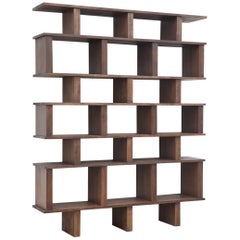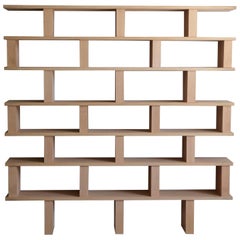Verticale Shelving Unit
Recent Sales
21st Century and Contemporary French Modern Shelves
Hardwood
21st Century and Contemporary French Modern Bookcases
Oak
21st Century and Contemporary French Modern Bookcases
Oak
Design Frères for sale on 1stDibs
Design Frères is an eclectic furniture line designed by Eric Thévenot, owner of Blend Interiors, an exceptional California-based dealer of vintage and contemporary furniture and decor.
Known for synthesizing divergent styles and peppering worldly spaces he creates with works stemming from varying origins and periods, Thévenot is a consummate decorator, and the chairs, tables, case pieces and other furnishings that comprise his Design Frères collection are sophisticated additions to any interior.
Originally from France, Thévenot opened Blend Interiors in Los Angeles in 2005. While the company offers a range of furniture and decorative objects from all over the world — most of which are sourced from its founder’s purchasing trips in Paris — Blend Interiors also offers art advising services and interior design consulting. And the exclusive furnishings he is creating and manufacturing for the Design Fréres collection are part of this endeavor to provide clients with a provocative fusion of design.
"I believe in mixing periods: Saarinen chairs in a French chateau, Louis XVI armoires in a futuristic pad," Thévenot has said. “I like pulling things out of different time periods and re-creating them for today’s lifestyle.”
Building on Blend Interior’s success, Design Frères was established in 2010 and is a growing venture.
Given the broad-ranging tastes and concepts at the core of Blend Interiors, it is appropriate that the Design Frères line is so diverse and interesting — the collection features Art Deco-style end tables topped with travertine and stylish counter stools with handwoven rush seats and slender frames of powder-coated steel. Elsewhere, Thévenot’s white oak shelving systems feature chic space elements and draw on the legendary mid-century modernist storage solutions designed by the likes of Charlotte Perriand and Jean Prouvé, with each piece pairing nicely with the vintage European treasures that Thévenot is prone to acquire on his next trip to Paris.
On 1stDibs, find Design Frères tables, seating and lighting.
A Close Look at Modern Furniture
The late 19th and early 20th centuries saw sweeping social change and major scientific advances — both of which contributed to a new aesthetic: modernism. Rejecting the rigidity of Victorian artistic conventions, modernists sought a new means of expression. References to the natural world and ornate classical embellishments gave way to the sleek simplicity of the Machine Age. Architect Philip Johnson characterized the hallmarks of modernism as “machine-like simplicity, smoothness or surface [and] avoidance of ornament.”
Early practitioners of modernist design include the De Stijl (“The Style”) group, founded in the Netherlands in 1917, and the Bauhaus School, founded two years later in Germany.
Followers of both groups produced sleek, spare designs — many of which became icons of daily life in the 20th century. The modernists rejected both natural and historical references and relied primarily on industrial materials such as metal, glass, plywood, and, later, plastics. While Bauhaus principals Marcel Breuer and Ludwig Mies van der Rohe created furniture from mass-produced, chrome-plated steel, American visionaries like Charles and Ray Eames worked in materials as novel as molded plywood and fiberglass. Today, Breuer’s Wassily chair, Mies van der Rohe’s Barcelona chair — crafted with his romantic partner, designer Lilly Reich — and the Eames lounge chair are emblems of progressive design and vintage originals are prized cornerstones of collections.
It’s difficult to overstate the influence that modernism continues to wield over designers and architects — and equally difficult to overstate how revolutionary it was when it first appeared a century ago. But because modernist furniture designs are so simple, they can blend in seamlessly with just about any type of décor. Don’t overlook them.
Finding the Right Bookcases for You
Whether you proudly shelve your books in regal mahogany or behind glass cabinet doors, an antique bookcase — or perhaps more than one — is essential to creating a cozy nook for any book lover.
As long as curious people have collected stories, we have needed a place to stow them away and preserve them. When auction houses and book dealers proliferated by the late 17th century, the bibliophile was born. And, of course, as with any treasured decorative objects or collectibles, a book lover’s volumes were suddenly worthy of a luxurious display — enter the bookcase.
Americans of means during the 19th century took to amassing art as well as rare books, and bookcases of the era — rife with hand-carved decorative accents and architectural motifs — were ideal for displaying their handsome leather-bound wares.
Although our favorite titles may change over the years, the functionality and beauty of their home within our home is timeless. Even those who don’t covet the perfect home library can benefit from an attractive display case, as bookcases can easily double as charming étagères.
Contemporary and customizable options make it easier for you to find the perfect bookcase for your style and stacks. If you don’t wish to fill your storage piece so that your collection is snug within its confines, incorporate extra space to allow for additional displays and decorative objects. And by introducing a striking dark wood Art Deco bookcase or low-profile mid-century modern design by Paul McCobb into your living room, your signed first editions won’t be the only items making a statement.
Find barrister bookcases, Globe Wernicke bookcases, bookcases with doors and other vintage and antique bookcases on 1stDibs now.

